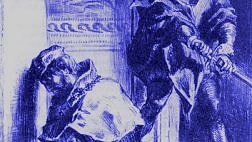 CHECK OUT YOUR FREE
CHECK OUT YOUR FREE
SAMPLE ESSAY BELOW

Check out your free
sample essay below

Essay introduction /
Thesis statement
“Where is thy father?”
Hamlet contains two revenge stories, the second triggered by the first halfway through. At the play’s end, an accidental swapping of swords between the two duellers Laertes and Hamlet is followed by a genuine exchange of forgiveness.
Their deadly fencing match reverses the outcome of another duel fought thirty years before, as Young Fortinbras from the rival kingdom of Norway succeeds to Denmark’s vacant throne.
Hamlet is a warning both against revenge and against revenge plays. For the cycle of vengeance begins with the title character staging a play about revenge (“a knavish piece of work … writ in choice Italian”, 3.2) that so enrages him with blind fury he kills the wrong man (“Dead for a ducat”, 3.4). In so doing, Prince Hamlet succeeded only in creating another revenge-obsessed son, Laertes, like himself.
SHARE THE SHAKESPEARE
#Hamlet dies naming as king a prince who is more like his father King Hamlet than he ever was.
1
Hamlet and his ghost-father
“Thy dread command”
We, the audience, hear Claudius’ confession (“O heavy burden!”, 3.1). But what if, like Hamlet, we had not? What would we do? Lacking certain knowledge, no amount of “thinking too precisely on th’ event” (4.4) helps Hamlet, a man of reason, to reason his way to a solution. He “cudgels” his “brains” (5.1) in vain.
More generally, Hamlet’s dilemma is between acceptance and action: should we endure our world of “slings and arrows” as it is (“To be”). Or risk everything including our lives by taking on “a sea of troubles” and seek to change the world for the better? (“not to be”, 3.1).
For Christians, vengeance belongs only to God, but as Hamlet later asks Horatio, might a Christian not also “in perfect conscience!” take a life to prevent “further evil!” (5.2)?
SHARE THE SHAKESPEARE
#Hamlet: The prince swears an oath only to "remember" his father's Ghost, not to avenge him.
2
Hamlet and his aunt-mother
“Up, sword … My mother stays”
It is not Claudius’ guilt but Hamlet’s secret knowledge of his father’s death and the threat he poses to the king that is revealed by The Mousetrap with its murderous figure of Lucianus, “nephew to the king” (3.2).
In the chapel and closet scenes, Hamlet’s aim becomes clear: to reunite in the afterlife his fractured family of mother and father. Hence his desire to rescue Gertrude’s soul (“Confess yourself to heaven”, 3.4) before he condemns his uncle’s (“as damned and black / As hell, whereto it goes”, 3.3).
Ironically, Hamlet’s wish to damn Claudius’ soul saves the life of the apparently praying king. And his blind stabbing of Polonius only creates a second vengeful son. Like Laertes in the final scene (“as a woodcock to mine own springe”, 5.2), Hamlet is caught in his own ‘Mousetrap’.
SHARE THE SHAKESPEARE
King Claudius is haunted by the murder he has committed. Prince #Hamlet by the murder he hasn't.
3
Laertes: the impulsive avenger
“I’ll be your foil”
The Ghost’s revelations sent Hamlet retreating inward into untrusting isolation. Polonius’ bereaved son instead reaches outward to lead a rebellious, castle-storming mob against the king.
However, the contrast between Laertes and Hamlet is not between action and delay but between reason and passion. The prince evaded Claudius’ offer to “think of us / As of a father” (1.2). In his unthinking rage, Laertes submits to the king’s invitation: “Will you be ruled by me?” (4.7).
Hamlet reflected that “conscience does make cowards of us all” (3.1). Laertes consigns conscience “to the profoundest pit” (4.5). Hamlet knows how a man may tremble in “the dread of something after death” (3.1). Laertes dares “damnation” (4.5).
SHARE THE SHAKESPEARE
Laertes, the avenger #Hamlet created, is also the man who pardons the prince.
4
Young Fortinbras: the patient opportunist
“Lands lost by his father”
No one delays longer than Fortinbras. Thirty years lapse before he makes his move against Denmark, and then when his father’s killer is himself dead.
Elsinore’s guards unhesitatingly swear an oath with Hamlet on the prince’s sword before departing in a soldier-like band of brothers: “come, let's go together” (1.5). Laertes’ inspiring passion is capable of moving an unarmed crowd to rebellion.
In contrast, Fortinbras’ only followers are hired mercenaries (“lawless resolutes”, 1.2) and, later, soldiers directed to do by his uncle. His Polish adventure one of his own captains dismisses as a purposeless quest for “a little patch of ground” (4.4).
Fortinbras’ good fortune was to be in the right place and time when Denmark’s royal family of Hamlet self-destructed.
SHARE THE SHAKESPEARE
In #Hamlet, no one delays longer than the land-grabbing opportunist, Young Fortinbras.
5
Essay conclusion / Summary
“Exchange forgiveness with me”
Despite the nobles’ cry of “Treason” (5.2), the prince strikes his villainous uncle: with the poisoned sword (for his own death) and poisoned wine goblet (for this mother’s). It is more public execution than private vengeance. The ending brings not just comeuppance but forgiveness too: Laertes, the avenger Hamlet’s desire for revenge created, is also the man who pardons the prince.
As for Old King Hamlet (“Alas, poor Ghost”, 1.5), by surrendering Denmark to his rival’s son perhaps the prince has granted his “dear father” (2.2) something more than revenge: forgiveness for his land-grabbing, “Extorted treasure in the womb of earth” (1.1) sins committed “in his days of nature” (1.5)—and with it escape from his suffering in the “sulfurous and tormenting flames” (1.5) of purgatory.
SHARE THE SHAKESPEARE
#Hamlet grants his father not the revenge he demanded but the atonement his suffering soul needed more.
6
The most helpful book ever for students and teachers of Shakespeare’s Hamlet.
42 x 1,500-word model essays

Chapter-by-chapter guide to Hamlet Model Essays
IN THIS BOOK ARE THREE 1,500-WORD SAMPLE ESSAYS ON EACH ONE OF THE FOLLOWING 14 CHARACTERS, RELATIONSHIPS, AND THEMES. THAT’S 42 SAMPLE ESSAYS IN TOTAL.

#1: The Character of Hamlet
Born a prince, parented by a jester, haunted by a ghost, destined to be killed for killing a king, and remembered as the title character of a play he did not want to be in. If at the cost of his life, Hamlet does in the end “win at the odds.”

#2: The Character of Claudius
His “ambition” for Denmark’s crown leads him to commit one murder only to find that he must plot a second to cover up the first. When this plan fails, his next scheme leads to the death of the woman he loves followed by his own.

#3: The Character of Gertrude
“Have you eyes?”, Prince Hamlet demands of his mother. Gertrude‘s “o’erhasty marriage” dooms her life and the lives of everyone around her when her wished-for, happy-ever-after fairytale ends in a bloodbath.

#4: The Character of Ophelia
As she struggles to respond to the self-serving purposes of others, Ophelia’s sanity collapses in Elsinore’s “unweeded garden” of falsity and betrayal. Her “self-slaughter” is her revenge for her silencing and humiliation.

#5: Relationship of Hamlet and the Ghost
Hamlet grants the Ghost the atonement his suffering soul needed more than the revenge he demanded: he surrenders Denmark to the son of the man murdered by his father on the day of the prince’s birth.

#6: Relationship of Hamlet and Claudius
Uncle and nephew are two men at war with each other—and themselves. Claudius is haunted by the murder he has committed (“O heavy burden!”); Hamlet by the one he hasn’t yet (“Am I a coward?”).

#7: Relationship of Hamlet and Gertrude
A haunted-by-the-past Hamlet seeks the truth about his father’s death (“Do you see nothing there?”). A live-in-the-present Gertrude seeks to protect her second husband and crown (“No, nothing but ourselves”).

#8: Relationship of Hamlet and Ophelia
Their relationship begins in uncertainty, descends into mutual deceit and rejection, and ends with their double surrender to death: Ophelia, to the water; Hamlet, to Claudius’ rigged fencing duel.

#9: Relationship of Hamlet and Horatio
“Those friends thou hast … Grapple them unto thy soul with hoops of steel.” Horatio is Hamlet’s trusted confidant in life and vows to remain the keeper of his memory after the prince’s death.

#10: Relationship of Claudius and Gertrude
A marriage of mutual self-interest: Claudius wanted to become king; Gertrude wanted to remain queen. In the end, both die by the same poison her second husband used to murder her first.

#11: Main Themes of Hamlet
A king murdered, an inheritance stolen, a family divided: Elsinore’s older generation destroys its younger when two brothers—one living, one undead—battle in a “cursed spite” over a crown and a queen.

#12: The Theme of Revenge
Hamlet and Laertes journey from revenge, through obsession and anger, to forgiveness. And the revenge sought by the Ghost on King Claudius becomes the revenge of Old King Fortinbras on Old King Hamlet.

#13: Deception and Appearance versus Reality
“Who’s there?” The characters struggle to distinguish between truth and falsehood in a play-long triple pun on the verb ‘to act’: to take action, to behave deceitfully, and to perform in theater.

#14: The Theme of Madness
“Your noble son is mad”, Polonius tells Denmark’s king and queen. But is Hamlet ever really insane? If not, why is he pretending to be? And is the prince’s “antic disposition” the cause of Ophelia’s traumatic breakdown?
















